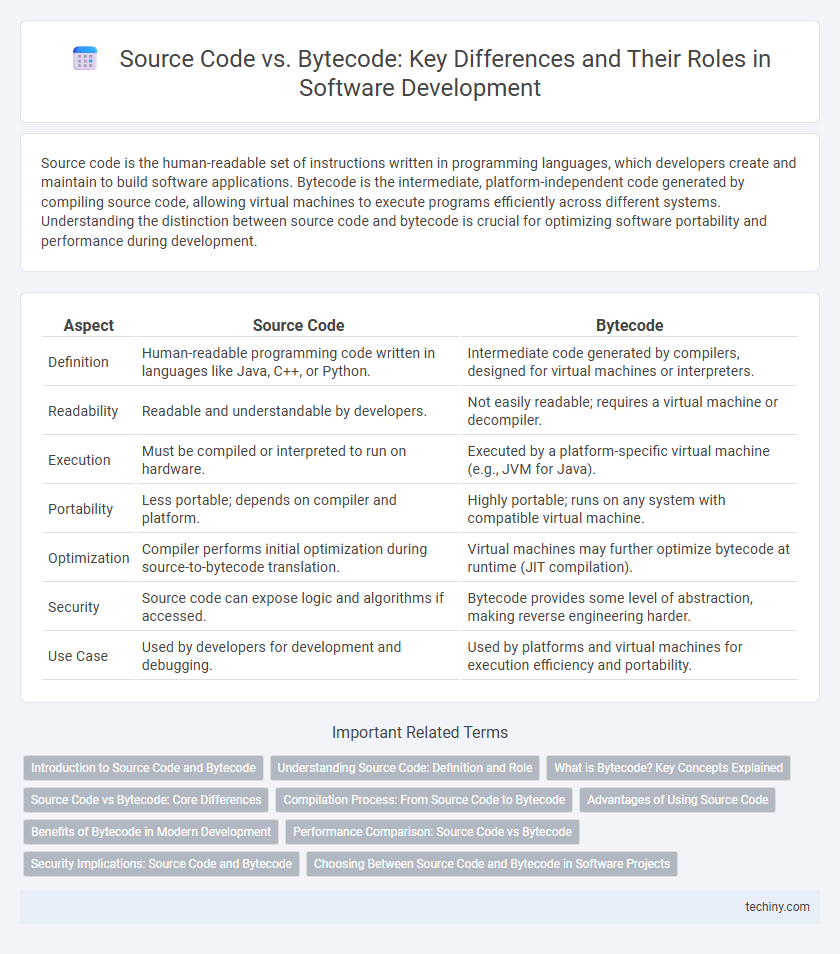Source code is the human-readable set of instructions written in programming languages, which developers create and maintain to build software applications. Bytecode is the intermediate, platform-independent code generated by compiling source code, allowing virtual machines to execute programs efficiently across different systems. Understanding the distinction between source code and bytecode is crucial for optimizing software portability and performance during development.
Table of Comparison
| Aspect | Source Code | Bytecode |
|---|---|---|
| Definition | Human-readable programming code written in languages like Java, C++, or Python. | Intermediate code generated by compilers, designed for virtual machines or interpreters. |
| Readability | Readable and understandable by developers. | Not easily readable; requires a virtual machine or decompiler. |
| Execution | Must be compiled or interpreted to run on hardware. | Executed by a platform-specific virtual machine (e.g., JVM for Java). |
| Portability | Less portable; depends on compiler and platform. | Highly portable; runs on any system with compatible virtual machine. |
| Optimization | Compiler performs initial optimization during source-to-bytecode translation. | Virtual machines may further optimize bytecode at runtime (JIT compilation). |
| Security | Source code can expose logic and algorithms if accessed. | Bytecode provides some level of abstraction, making reverse engineering harder. |
| Use Case | Used by developers for development and debugging. | Used by platforms and virtual machines for execution efficiency and portability. |
Introduction to Source Code and Bytecode
Source code is the human-readable set of instructions written in programming languages like Java, Python, or C++, serving as the foundation for software development. Bytecode is an intermediate, platform-independent representation of source code, generated by compilers to be executed by virtual machines such as the Java Virtual Machine (JVM). This transformation from source code to bytecode enables efficient execution and portability across different operating systems and hardware architectures.
Understanding Source Code: Definition and Role
Source code is the human-readable set of instructions written in programming languages like Python, Java, or C++, forming the foundation for software development. It serves as the blueprint for creating applications and is essential for debugging, maintaining, and enhancing software functionality. Understanding source code enables developers to translate ideas into executable programs, bridging conceptual design and machine-level execution.
What is Bytecode? Key Concepts Explained
Bytecode is an intermediate code generated from source code during the compilation process, designed for execution by a virtual machine rather than directly by hardware. It offers platform independence, allowing programs written in languages like Java and Python to run on any device with a compatible runtime environment. Bytecode optimizes performance and security by enabling efficient execution and safeguarding source code against direct exposure.
Source Code vs Bytecode: Core Differences
Source code consists of human-readable instructions written in programming languages like Java or Python, while bytecode is a low-level, platform-independent representation generated after compiling source code. Source code allows developers to write and understand the logic, whereas bytecode serves as an intermediate step executed by virtual machines such as the Java Virtual Machine (JVM). The key difference lies in abstraction: source code is high-level and editable, bytecode is optimized for efficient execution across different platforms.
Compilation Process: From Source Code to Bytecode
The compilation process transforms human-readable source code, written in languages like Java or C#, into bytecode, a low-level, platform-independent code executed by virtual machines such as the Java Virtual Machine (JVM). Source code undergoes lexical analysis, syntax parsing, and semantic checking before being compiled into bytecode that serves as an intermediate representation optimized for runtime efficiency. This bytecode enables cross-platform compatibility, allowing programs to run seamlessly across different operating systems without recompilation.
Advantages of Using Source Code
Using source code allows developers to write, debug, and maintain software with greater clarity and flexibility, enabling direct modification and optimization of the program. Source code facilitates easier collaboration among development teams through readable and understandable instructions, improving code quality and reducing errors. It also supports rapid prototyping and customization, which is essential for adapting software to specific user requirements or evolving technologies.
Benefits of Bytecode in Modern Development
Bytecode enhances cross-platform compatibility by enabling software to run consistently on any virtual machine, regardless of underlying hardware or operating systems. It improves security through sandboxing, isolating code execution to prevent malicious behavior and unauthorized access. Bytecode also facilitates faster program execution with just-in-time compilation and reduces development time by allowing easier debugging and automated optimization.
Performance Comparison: Source Code vs Bytecode
Source code, written in high-level languages like Java or Python, requires compilation or interpretation before execution, impacting initial performance due to parsing overhead. Bytecode, a platform-independent intermediate representation, enhances runtime efficiency by enabling just-in-time (JIT) compilation and optimizations tailored to the host environment. Consequently, bytecode often outperforms direct source code interpretation by reducing execution time and improving resource utilization across diverse systems.
Security Implications: Source Code and Bytecode
Source code exposes the software's logic and algorithms, making it vulnerable to reverse engineering and intellectual property theft if accessed by malicious actors. Bytecode, being a lower-level, platform-independent representation, offers a layer of abstraction that can hinder direct interpretation but is still susceptible to decompilation and tampering. Implementing obfuscation techniques and secure bytecode verification processes enhances protection against unauthorized code analysis and potential security breaches.
Choosing Between Source Code and Bytecode in Software Projects
Choosing between source code and bytecode in software projects depends on factors like platform compatibility, performance requirements, and ease of debugging. Source code offers readability and straightforward maintenance, making it ideal for development and collaboration, while bytecode enables cross-platform execution and often better runtime efficiency when used with virtual machines like the JVM. Evaluating the software's deployment environment and scalability needs ensures optimal selection between source code and bytecode for successful project outcomes.
Source Code vs Bytecode Infographic

 techiny.com
techiny.com